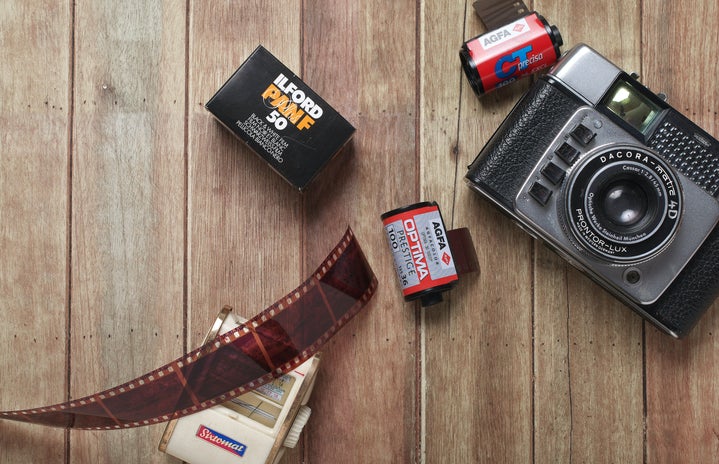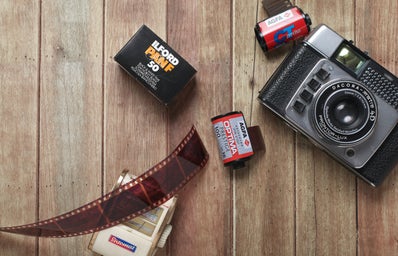Photography is one of my favourite hobbies, whether I’m gearing up to take some partly successful self-portraits or just pulling out my camera during an outing with my friends. Chances are most of us indulge in photography: thanks to technology, it’s easy for us to take high-quality pictures of anything we desire with the devices we have at our fingertips.
However, lately, as with many “retro” things like record players and flip phones, film photography has been making a comeback. Yes, this generation loves the old, nostalgic appearance and feel of film — rightfully so.
So, if that’s the case, is it worth getting a film camera? What about a digital camera instead?
As an amateur photographer with both a film camera and a DSLR, I can tell you that both have their respective advantages and disadvantages.
Film
One of the biggest appeals of a film camera, which draws new users to it in the first place, is nostalgia. Taking a picture with an actual camera and then getting the roll developed at a little shop is starkly different from snapping a pic on a phone and stuffing it back into your pocket. Plus, there’s the desired old look of film: grainy, blurry, and a little too dark or too light — you can’t beat it!
Having physical copies of pictures is another big appeal of film. Personally, I love putting my film prints in a scrapbook and decorating the pages with stickers and writing, taking note of all the dates and giving some context. As you collect your film prints throughout the years, your albums will fill beautifully, painting a journey of you and your life. Frankly, having hard copies of pictures is always more intimate than digital ones.
Of course, you can print out your digital photographs as well, but there’s one thing that misses: the excitement of waiting and receiving the pictures. After some time, you forget what’s even on that roll of film, and when you get it printed, you’re left with the surprise of finding out what’s on there (especially if you let others take pictures on your camera).
Regarding the price, film cameras tend to be less expensive than digital cameras. However, the cost of film stacks up, especially if you’re using your camera frequently. So, if you’re looking for the cheaper option outright, go for a film camera (just be prepared to set some extra money aside).
As for the cons, since you can’t see how the pictures look as you take them, you don’t know how they’re going to turn out. Even though I’ve been using film for a couple of years now, I can never be sure if the lighting is too bright or too dark and how the image will show up on film. However, if you’re smarter than I am, you might manage in time.
In a similar way, you’ve got to decide what kind of film you want to use: consider the brand, colour or black and white, and ISO. This issue, however, is one that you’ll solve over time as you experiment with different kinds and decide which film best suits your taste and settings.
Overall, film cameras tend to be easier to use than digital ones (assuming it’s a point-and-shoot) and have a beautiful look and nostalgic feeling that digital cameras just can’t replicate.
DSLR
Unlike film cameras, digital cameras provide instant results — you can see how your image turned out mere seconds after taking it and can thus retake it if someone blinks or if you want to try a different technique. Even if you keep messing up the pictures, you can always rely on those trusty auto settings, allowing the camera to automatically adjust to the environment and provide great results.
Unlike film, which relies on a certain number of exposures at a time, digital cameras have memory cards, meaning you can afford to take far more pictures. With film, you have to use your camera sparingly, ensuring you don’t waste that costly roll of film, whereas with digital cameras, you’ll just be wasting memory card space and can delete pictures as need be. This is especially advantageous if you print your pictures because then you’ll have physical copies and won’t have to leave them on the memory card, allowing space for more photos.
In terms of the pictures’ appearance, digital cameras provide clearer results: they are much more HD, with a better focus and resolution than film. As such, it can be better for portrait or nature photography.
While more expensive than film cameras, digital cameras don’t require any film. If you’re looking for an investment, a digital camera is the way to go.
However, even without film, the cost can add up: you may need attachments — such as an external flash or other types of lenses — if it’s not simply a point-and-shoot camera and you want to enhance your photography.
Also, unlike a film camera, digital cameras have a battery that needs to be recharged, so you’ll have to make sure you do so before doing any photoshoots, otherwise, you’ll be left with a camera but no way to use it. Trust me, there’s nothing worse than getting excited to take some cool pictures and then realizing you forgot to charge your camera’s battery. Instant mood-killer.
MY FINAL Takeaway
I would argue that one form of photography isn’t better than the other: both have their respective appeals, and it really depends on what the individual photographer is looking for to best decide which kind of camera is optimal. Personally, I like using my DSLR for portraits and proper “photoshoots” and my film camera for spontaneous, fun occasions, like when I go out with my friends.
You can always do some more research on which of the two mediums would best suit your desires. Whatever you choose, make sure you take amazing pictures and keep your best memories alive. After all, there’s no better means of preservation than photography.


